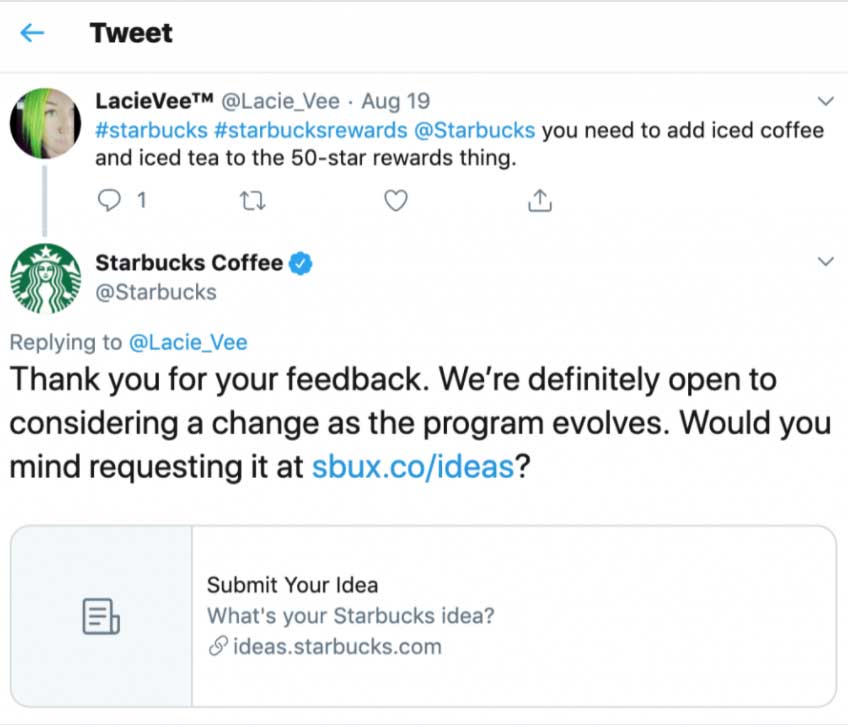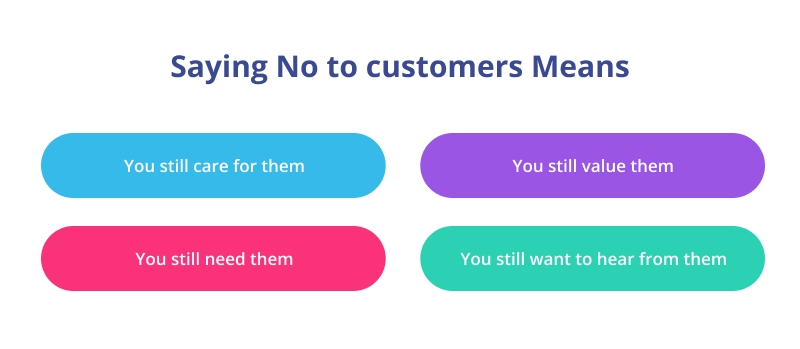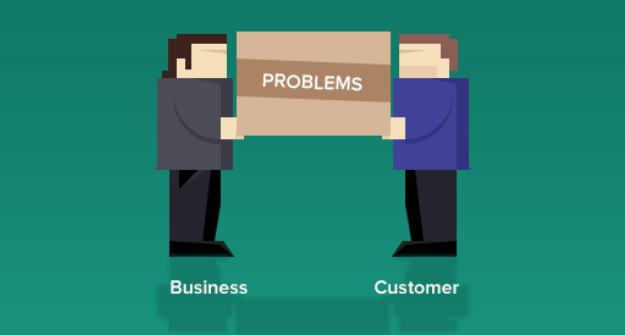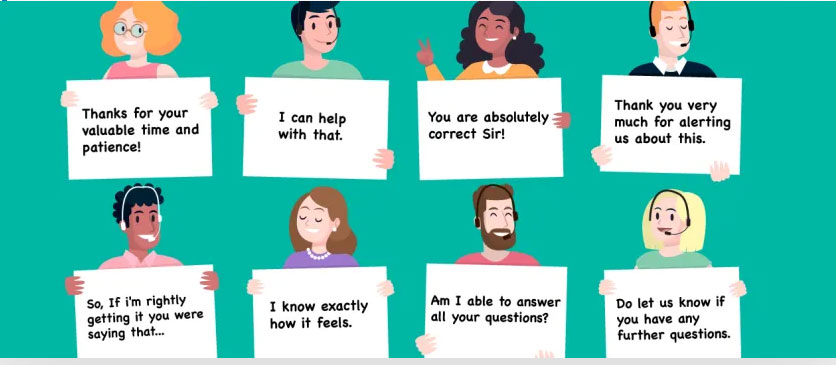Saying “No” to customers is easily among the toughest conversations for any business.
However, there are situations when fulfilling the request does not feel possible yet the inability to do feels bad at many levels.
After all, when you turn down someone, they would probably not take it well and might not return again. And it can affect your organization.
70% of unhappy customers will return and shop again with your company if your business solves their problem.
So, in order to handle these scenarios efficiently, you need to strike a balance between how to saying no to customers and still keeping them engaged with the business.
The best possible response will be to hear what customers say, show interest in their demands, and then respond to them in a positive manner.
9 Real Life Examples of How to Say “No” to Customers
It’s never easy to tell customers no — especially to those who you see as a prospect. Luckily, there are some effective strategies to serve the intended purpose without having to deny anyone. You can also learn how to decline a request politely and handle angry customers without offending someone and still benefit from the situation.
There are many ways you can say no to clients and still hope to retain their benevolence.
- Understand the Root Cause of Problems
- Listen First and Then Reply
- Explain Things in Detail
- Frame Your Response Carefully
- Be Empathetic
- Offer the Alternatives
- Avoid Standard Responses
- Seek Customer Feedback
- Take Follow-ups
Let’s dive into each of the ways in detail:
1. Understand the Root Cause of Problems
Some of your customers may come up to you with a request that might seem bizarre to you. Or, a demand that looks unreasonable to meet.
In such cases, you might feel tempted to forsake any customer service etiquette to answer them in a negative way and finish off the matter in a jiffy.
It would however be a mistake to immediately say no to customers without knowing the problem inside out.
The right response is to first get to the root of the problem, properly understand the motivation behind the request, and then think of the next course of action.
Here’s an example:
You are an online retail shop that recently discontinued the cash-on-delivery (COD) system for one particular area of the market for some strategic reasons. Now, when one of your customers wants the service back and approaches you with the request.
Even if you don’t intend to roll back the COD anytime soon, you could still be polite with the customer, suggest the benefits of the available option, and may even assure them of the return of the service in the near figure.
Tips to understanding the root cause of problems
- Encourage the customer to give an opinion on how to make the system better as this will give an impression that they are valued by your business.
- If you can’t solve the existing problem, offer an alternative solution so that the customer feels good.
- Maintain a helping demeanor so that the customer feels like they matter to your business.
REVE Chat offers a suite of advanced customer support tools that can help you engage better with users. Sign up to enrich your business with top engagement tools and start delivering quick responses to customers.
2. Listen First and Then Reply
Customers can reach your business from many channels.
And if you don’t have an appropriate customer response system in place, it will be difficult to manage conversations effectively.
When you’re ready to listen to what customers have to say, it means you’re ready to serve them better.
The right approach is to take customer communications seriously, attend to their request immediately, and then proactively reach out for help.

For example, Starbucks knows how to give value to customers and the above example is a clear case of its approach to solving problems.
How to listen to your customers?
- Don’t let any customer message go unanswered and even if there is an angry outburst, make sure you attend to the conversations as soon as possible.
- Implement a multi-channel approach so that customers can find more ways to present their issues in front of your business
- Make sure you proactively help your customers so that they feel valued.
3. Explain Things in Detail
Customers ideally want to listen a “YES” when they approach brands with a request. And when they don’t get a favorable response, they wish to at least know the rationale behind the denial.
If you are in a situation where an affirmative answer from you is not possible, make sure you explain to customers the reason behind that.
Saying ‘No” without explanation can make your customers feel upset and frustrated. This can might also dilute your customer relationship management effort in a big way.
However, if there is a detailed explanation, it can definitely make the frustration a little less stingy for sure.
So, if you want to understand how to politely decline a business request feels like, give a proper reason for the denial.
Here are some of the examples of how to say no to customer requests by explaining things in detail:
“We are sorry to meet your request at the moment due to an ongoing service issue at our end. The moment our process is restored, we will get back to you and take things further from there….”
“The request you have made falls outside the purview of our company policy. We understand your issue but are bound by the rules.…”
“Serving you has always been a privilege to us. This time around we would have liked to make available the feature you requested but are unable to do it due to maintenance work at our end.”
4. Frame Your Response Carefully
Customers always like a great experience with brands. And they also expect businesses to respond in a positive manner.
So, even if you intend to say no, make sure your response is framed with some care to avoid any damage to customer goodwill with your business.
After all, more than your intent, the word you use, and the tone you choose to respond will linger on with customers.
For that reason, you should avoid a denial outright and rather be diplomatic in terms of interacting with them.
Here are some of the examples of how to tell a customer you cannot help them and still frame your response gracefully:
“We appreciate your time and effort in sharing with us. Unfortunately, we’re unable to implement this right way, but you can still be hopeful for the future…”
“Thanks to you for bringing our attention to this issue. Let us see what we can do best for this situation.”
“The reason we’re not able to offer this is that….”
How to frame your response gracefully?
- Be always careful with the words you choose for customers. And if possible, replace “no” with positive words.
- When dealing with customers, always maintain politeness so that a bad vibe is never passed down.
- To ensure the best possible response, make sure you hear customers inside out, see through their problems, and then go about responding to them.
5. Be Empathetic
Brands that follow the policy of empathy are more likely to retain the trust of their customers.
So, whenever your business has to say no to customers, make sure it comes with a sense of empathy otherwise you might come across as rude.
The focus should be on putting yourself in customer’s shoes and then realizing the value of their concerns.
If you’re able to empathize with customers, you’re almost likely to get them returned convinced.
Best practices in empathizing with customers
- Never doubt customer’s concerns as they may have come to you with certain expectations and make sure you find some value in their request.
- Maintain a professional demeanor in dealing with customers in situations when you have to turn down customers without coming across as curt.
- Mirro the tone of customers to look genuinely empathetic and always try to give customers the space to pour their heart out without feeling unwanted.
6. Offer the Alternatives
There may be situations when you feel more than capable yet are unable to meet the exact demands of the customer for some reason.
On top of that, you also don’t want to deny customers a request that is not that steep.
For such scenarios, you can offer alternatives to customers and minimize their pain to some extent.
And by offering alternatives to customers, you not only avoid the situation of how to decline a request politely but also make them feel valued.

Benefits of offering alternatives to customers
- Implementing the policy of alternatives can help your business achieve higher customer satisfaction and trust.
- Customers always want to feel valued and giving them an alternative rather than rejecting them can make them return to you again.
- Customer churn will be minimized when you have a policy of giving options and showing concern to their problems.
7. Avoid Standard Responses
If your business is tarring all the customers with the same brush, it’s definitely heading on the wrong track.
After all, customers want to feel unique in all situations and standard response does not fit well into that narrative.
Worse still, they generally feel bad when brands offer them templated responses for concerns.
So, even when you have to deny a customer, make sure the response does not feel like the one you have a “copy and paste” system as it might fail to convey the right message.
How to avoid standard responses to customers?
- Rather than offering a template message to customers, you can be honest about the situation and clearly tell your inability to meet their request at a moment.
- For situations where standard response becomes necessary, you can be genuine and offer an apology for putting the customers through this.
8. Seek Customer Feedback
Customer feedback should matter to your business, more than many other things. It will show that you look to handle customer complaints at all times.
If you want to create happy customers, there is no way you can avoid seeking feedback.
More importantly, if you have been dealing with saying no to customers more often than you’d ideally prefer, it means your feedback mechanism is faulty.
One major advantage of seeking customer feedback is to avoid situations in the future when you have to turn down customers.
Popular customer feedback methods
- Live Chat – Using chat surveys could be one of the best methods for collecting customer feedback because live chat is now a top channel preferred by customers to reach out to businesses.
- Social Media Monitoring – Customers love social sites to reach out to business so you need to monitor popular channels to meet their requirements efficiently.
- Customer Interviews – When your business reaches in a position to say no to customers, it can use that moment to its advantage by collecting feedback and implementing the changes.
9. Take Follow-ups
After having said no to a customer, you may feel like being in the wrong in some way. You however can use this situation to your advantage and delight customers again with proper follow-ups.
Rather than waiting to hear back from customers after a denial of service, you should be proactive and take the first step in reaching out to them.
A follow-up will help you recognize the customer signals and give you a roadmap in creating value for the business.
With a timely follow-up call, you can not only better understand what your customers want but can use the input to improve your customer support process.
Practical Scenarios When Saying ‘No’ to Customers is OK
A customer coming up with a request does not mean you need to fulfill it under all conditions. There are bound to be situations when you can say no politely in business and don’t feel bothered about the consequences. So, you need to assess the particular case and make the move accordingly.
Scenarios when saying no to customers is OK:
- Going against the company policy – It’s perfectly fine to not cede to a customer request when doing so can make you go against the company policy.
- Asked to share persona details – Giving personal details on either existing customers or agents is something you can avoid even if it irks your customers
- Being threatened – Customers sometimes may resort to verbally abusing you or may even threaten you with dire consequences and in such situations, you need not give in to their demands ever.
- Preference is expected – Be ready for situations where customers may ask for some kind of preference and if it does against the standard norms followed at your company, feel feel to say no to them immediately.
- When foul language is used – Don’t ever hesitate in saying no to customers when they use foul language to have their ways and you should not worry about losing them also.
Develop Comfort with Saying No to Customers and Win Trust
Having to say no to a customer does not mean you’re going to lose them forever. You can still retain their trust if you show respect and empathy to them. Rather than ending the conversation there itself, you need to make a follow-up and see how the customer is doing after the denial.
And when it comes to engaging customers more effectively, using the engagement tools is often the best step forward. Sign up to empower your business with top engagement tools and deliver value.
The right strategy should be to develop more comfort with saying no to customers without coming across as rude. After all, your business needs them to survive and even when you deny them once, there is always an opportunity to win them over with the right measures.








I am just starting my business and I find saying ‘no’ to clients that are not ideal quite difficult – however, it must be done. Mostly, the fear is around not having the income,.Thank you for this article. definitely it gonna to help me.
Thanks Adriane. Obviously saying ‘NO’ to a customer will be the last option. First try to find other way outs, and if nothing works, then only explain him/her why it’s not possible.
Great Article !
I agree with what you posted in this article. I know that this will help a lot of people to support customer. Points here, are very much logical. I appreciate you sharing this with us all.
Thanks Bastian.